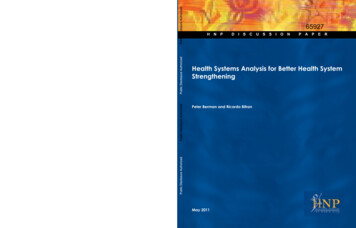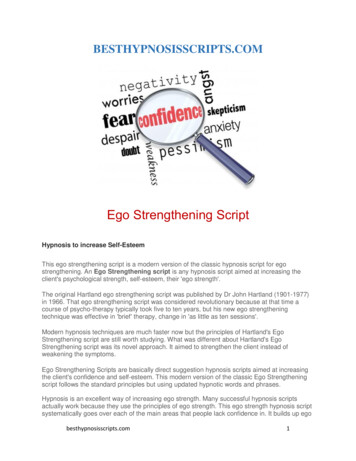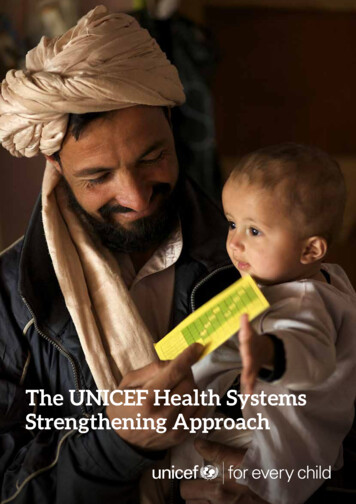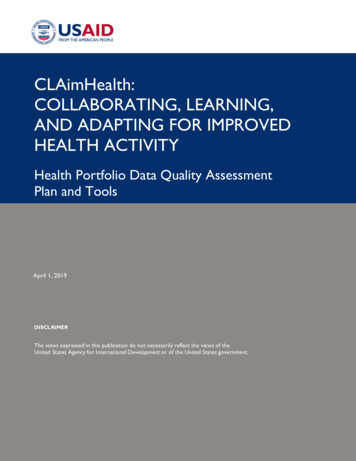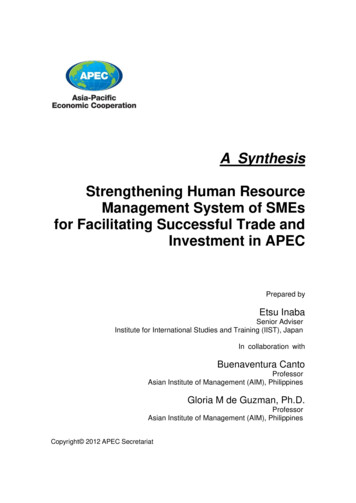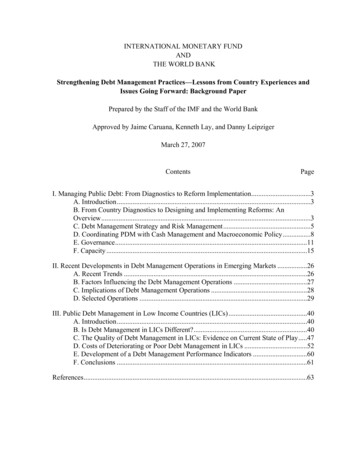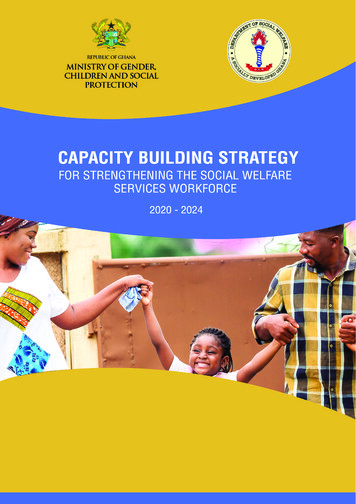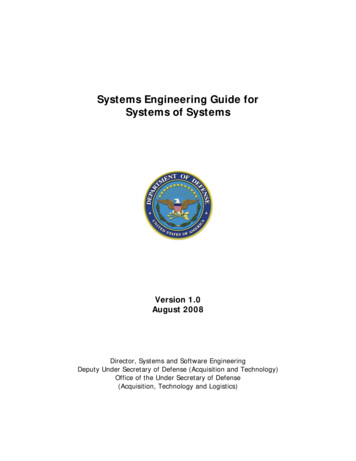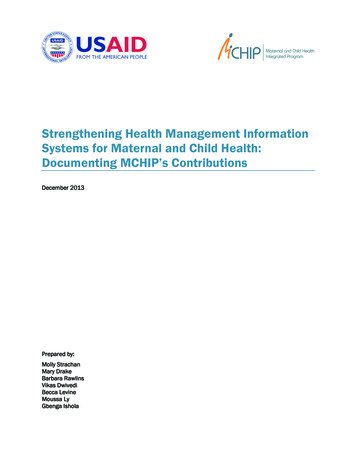
Transcription
Strengthening Health Management InformationSystems for Maternal and Child Health:Documenting MCHIP’s ContributionsDecember 2013Prepared by:Molly StrachanMary DrakeBarbara RawlinsVikas DwivediBecca LevineMoussa LyGbenga Ishola
Published by:Jhpiego CorporationBrown’s Wharf1615 Thames StreetBaltimore, MD 21231-3492, USA Jhpiego Corporation, 2013. All rights reserved.
Table of ContentsACKNOWLEDGMENTS . ivABBREVIATIONS AND ACRONYMS .vEXECUTIVE SUMMARY. viiINTRODUCTION. 1BACKGROUND . 2HMIS STRENGTHENING . 4HMIS Resources.4Indicators .5Data Sources .7Data Management . 10Dissemination and Use. 13CONCLUSIONS, RECOMMENDATIONS, FUTURE DIRECTIONS . 19REFERENCES. 20ANNEX A. MOZAMBIQUE FP REGISTER. 21ANNEX B. NIGERIA M&E JOB AID . 31ANNEX C. CECAP RESULTS POSTER . 37ANNEX D. NEPAL ANC AND FCHV CALCIUM REGISTERS. 38Strengthening Health Management Information Systems for Maternal and Child Healthiii
AcknowledgmentsThe primary purpose of this paper is to document and share the Maternal and Child HealthIntegrated Program’s (MCHIP) efforts to improve maternal, newborn, and child health- -relatedelements of the routine national Health Management Information System (HMIS) in multiplecountries. This undertaking requires the inputs and contributions of many people, and theauthors would like to recognize those individuals who made this paper possible. First, we wantto thank the MCHIP country teams and their ministry partners in Democratic Republic ofCongo, India, Nigeria, Mali, Mozambique, and Rwanda for drafting or contributing to casestudies. We would also like to thank MCHIP technical teams for their contributions toaccurately documenting MCHIP’s achievements.In addition to the authors listed, the U.S.-based technical team included Kait Atkins, whodesigned and oversaw the online survey, and reviewers Anita Gibson, Linda Fogarty, and TheoLippeveld for providing thoughtful insights to strengthen the paper.We would also like to thank our colleagues at the United States Agency for InternationalDevelopment’s Office of Health, Infectious Disease and Nutrition, especially Allison Moran.This report was made possible by the generous support of the American people through theUnited States Agency for International Development (USAID), under the terms of the Leaderwith Associates Cooperative Agreement GHS-A-00-08-00002-00. The contents are theresponsibility of the Maternal and Child Health Integrated Program (MCHIP) and do notnecessarily reflect the views of USAID or the United States Government.The Maternal and Child Health Integrated Program (MCHIP) is the USAID Bureau for Global Health’s flagshipmaternal, neonatal and child health (MNCH) program. MCHIP supports programming in maternal, newbornand child health, immunization, family planning, malaria, nutrition, and HIV/AIDS, and strongly encouragesopportunities for integration. Cross-cutting technical areas include water, sanitation, hygiene, urban healthand health systems strengthening.ivStrengthening Health Management Information Systems for Maternal and Child Health
Abbreviations and AcronymsASCAgents de Santé CommunautaireANCAntenatal careARIAcute respiratory infectionASACOCommunity health associationBCCBehavior change communicationBCGBacille de Calmette et Guérin (TB vaccine)CECAPCervical cancer preventionCHCChild health careCHERGChild Health Epidemiology Reference GroupCHWCommunity health workerCSCOMsCentres de Santé CommunautaireDPTDiptheria, pertussis and tetanusEmONCEmergency Obstetric Neonatal CareEPIExpanded program on immunizationsFANCFocused antenatal careFCHVFemale Community Health VolunteersFPFamily planningHBBHelping Babies BreatheHIVHuman Immunodeficiency VirusHMISHealth Management Information SystemsHMNHealth Metrics NetworkHSAHealth service assistantsiCCMIntegrated community case managementICTInformation and communications technologyIECInformation, education, and communicationIUDIntrauterine deviceKMCKangaroo mother careLAMLactational amenorrhea methodL&DLabor and deliveryMCHIPMaternal and Child Health Integrated ProgramMDGMillennium Development GoalMedexMedical extension nursesMOHMinistry of HealthMOHCWMinistry of Health and Child WelfareM&EMonitoring and evaluationMNCHMaternal, newborn, and child healthStrengthening Health Management Information Systems for Maternal and Child Healthv
NSSKBasic newborn care and resuscitation program (Hindi translation)OPV-0Oral Polio Vaccine-0PCVPneumococcal Conjugate VaccinePPHPostpartum hemorrhagePPIUDPostpartum intrauterine devicePRRINNPartnership for Reviving Routine Immunization in Northern NigeriaRAPIDRegular appraisal of performance of immunizationRDQARoutine data quality assessmentREDReaching Every DistrictSBM-R Standards-Based Management and RecognitionSECNational essential community packageSVASingle visit approachTATechnical assistanceTATechnical Advisory GroupsTBTuberculosisTSHIPTargeted States High Impact ProjectUNICEFUnited Nations Children’s FundUSAIDUnited States Agency of International DevelopmentVIAVisual Inspection with acetic acidWHOWorld Health OrganizationviStrengthening Health Management Information Systems for Maternal and Child Health
Executive SummaryMCHIP is the U.S. Agency for International Development’s flagship global program for scalingup evidence-based interventions to help countries achieve the desired reductions in newbornand maternal mortality outlined in Millennium Development Goals 4 and 5. As part of it itsefforts to improve the quality of maternal, newborn, and child health (MNCH) care in lowincome countries, MCHIP has taken specific steps to improve the monitoring of MNCH servicesthrough strengthening routine HMIS. These efforts have led to better monitoring andevaluation, higher-quality data, and informed decision-making in 28 countries across MNCHinterventions. Ongoing efforts to improve HMIS will increase country and global access toinformation-rich systems to support MNCH program strengthening. This report summarizessuccessful HMIS-related interventions and innovations in countries where MCHIP is operatingand at the global level. It highlights what MCHIP has done to strengthen HMIS and whichMCHIP contributions have been integrated and institutionalized in national HMIS systems,and describes lessons learned.Heightened global attention to MNCH measurement and accountability requires significantinputs into the health management information system (HMIS). Globally and locally, MCHIPhas participated in 10 technical working groups that enhance HMIS coordination andleadership and supported six countries with human and financial HMIS resources. To improveroutine availability of data on content and quality of MNCH care, MCHIP has provided globaland country-level leadership to formulate and test new indicators or revise and update existingindicators. These indicators have been integrated with national facility- and community-basedHMIS data sources for new health programs, such as cervical cancer, for pilot initiatives in 14countries, and to strengthen existing registers and data collection tools in four countries.MCHIP has contributed to data management, data quality assessments, and strengthening ofdata flow and aggregation for both facility- and community-based programs in seven countries,and built the capacity of health care workers to use HMIS tools correctly and consistently inseven countries. Furthermore, MCHIP has facilitated the use of information products thatenable quick visualization of data such as results posters and scorecards in 12 countries, leadingto routine use of data for program monitoring and planning. These tools can lead to quickeraction, increased accountability, and revitalization of commitments to improve health outcomes.Data use to inform program planning, evaluation, and program improvement is the ultimategoal of a well-functioning HMIS system. To that end, MCHIP has developed or scaled upinnovative approaches such as Reaching Every District in 11 countries to improve the quality ofservices provided to clients and expand coverage of key interventions.Strengthening Health Management Information Systems for Maternal and Child Healthvii
viiiStrengthening Health Management Information Systems for Maternal and Child Health
IntroductionAccurate and timely information on health intervention coverage, quality, and equity is thefoundation of public health practice. Good measurement facilitates increased accountability ofnational and international bodies, improves the ability to monitor progress toward global,national, and sub-national goals and objectives, and is critical to identifying strategicadjustments required to meet commitments.The Maternal and Child Health Integrated Program (MCHIP), funded by the U.S. Agency forInternational Development (USAID), contributes to reductions in maternal, newborn, and childmortality and prioritizes impact at scale, which requires highly effective coverage at thenational level, sustained on a continuing basis. MCHIP’s global leadership role and mandateand the direct reach to over 40 country programs worldwide allow MCHIP to not only influencepolicies and programs that support improved health outcomes, but also to support systems thatunderpin these programs, including Health Management Information Systems (HMIS).Globally and locally, MCHIP has undertaken efforts to introduce interventions or innovations tostrengthen HMIS. MCHIP teams have collaborated with host countries to develop new ormodify existing data collection tools, introduce new indicators, enhance data managementprocesses, and strengthen data quality improvement activities. The collaborations also haveimproved data accuracy and timeliness, and, most important, promoted the use of data formanagement and monitoring purposes. This report summarizes successful HMIS-relatedinterventions and innovations in countries where MCHIP is operating and at the global level. Ithighlights what MCHIP has done to strengthen HMIS and which MCHIP contributions havebeen integrated and institutionalized in national HMIS systems, and describes lessons learned.The audience for this paper is primarily health and HMIS professionals and health decisionmakers who use data on a routine basis to inform the planning and improvement of healthprograms.Strengthening Health Management Information Systems for Maternal and Child Health1
BackgroundMCHIP is USAID’s flagship global program for scaling up evidence-based interventions to helpcountries achieve the desired reductions in newborn and maternal mortality outlined inMillennium Development Goals (MDGs) 4 and 5. Since 2008, MCHIP has worked with Ministriesof Health and others in over 40 low-income countries to improve the quality and coverage of newand long-proven, evidence-based maternal, newborn, and child health (MNCH) interventions. Anintegral part of improving intervention coverage and quality is being able to accurately measurethe intervention of interest. To this end, MCHIP has worked to improve measurement of MNCHinterventions and services, and engaged key partners at the global, national, and sub-nationallevels to work to improve indicators and data collection tools used in population-based surveys,health facility surveys, and national HMIS. This paper focuses on the work MCHIP has supportedto improve MNCH-related elements of the routine national HMIS in multiple countries.The MDGs and the 2005 Paris Declaration on Aid Effectiveness focused attention on globalhealth targets and require reporting on progress towards targets. These initiatives have led to agrowing global emphasis on measurement and accountability in health, including what is beingmeasured, how it is being measured, the quality of those data, and how they are being sharedand used. The Countdown to 2015 and UN Commission on Information and Accountability forWomen’s and Children’s Health were established to address the need for changes in the scaleand scope of MNCH strategies to reach MDGs 4 and 5, to track progress, and to hold countriesaccountable for the progress or lack of progress they are making toward meeting national-levelcommitments. The Call to Action for Child Survival – A Promise Renewed focuses on threepriority aims, one of which is to promote transparency and accountability of governments, civilsociety, and private sector partners through tracking and reporting on child survival strategies.Taken together, these initiatives highlight the priority and urgency that should be given tostrengthening routine HMIS. Furthermore, as technical approaches to MNCH evolve,concurrent advances are required to adequately and accurately monitor health outcomes andthe impact these advances are having in saving women’s and children’s lives.The organizing framework for this paper is that put forward bythe Health Metrics Network (HMN) (see Figure 1). HMN,launched at the World Health Assembly in May 2005, wasestablished to help countries and partners work together toimprove health information and monitoring systems and supportevidence-based decision-making. The Secretariat of the HealthMetrics Network is hosted by the World Health Organization(WHO), and members include ministries of health and nationalstatistics offices, multilateral agencies, global healthpartnerships, bilateral donors, and technical experts. HMNmembers developed the framework with the intention that itserve as “the universally accepted standard for guiding thecollection, reporting and use of health information by alldeveloping countries and global agencies” and therefore it is themost appropriate framework to shape this paper.To gather information on MCHIP’s experience working toimprove MNCH elements of national HMIS, MCHIPconducted a short survey of program staff using surveymonkey and including coded and open-ended questions aboutthe scope of country-led HMIS interventions, how theintervention was implemented and the results achieved.2Figure 1. The HMN FrameworkComponents and Standards of aHealth Information SystemHIS ResourcesIndicatorsData SourcesData ManagementInformation ProductsDissemination andUseStrengthening Health Management Information Systems for Maternal and Child Health
MCHIP’s monitoring and evaluation (M&E) team also conducted follow-up interviews withprogram staff and stakeholders in six countries—Democratic Republic of Congo, India, Nigeria,Mali, Mozambique, and Rwanda. This information was supplemented with information fromMCHIP’s Annual and Quarterly Reports.Strengthening Health Management Information Systems for Maternal and Child Health3
HMIS StrengtheningFollowing the six components of the health information system as shown in the HMNFramework (Figure 1), below we provide examples of the types and breadth of support MCHIPhas provided across 28 countries to strengthen HMIS. Financial, human, and materialresources are the foundational inputs required for a strong and functional HMIS. Indicators,data sources, and data management are the processes leading to outputs such as informationproducts and dissemination and use of data (see Figure 2).Figure 2. Logic model for components of HMISInputs HMIS ResourcesProcess Indicators Data Sources Data ManagementOutputs Information Products Dissemination andUseHMIS RESOURCESStrong HMIS systems require a constant flow of resources—human, financial, and material—toestablish and maintain effective and efficient services. HMN’s Framework describes theseresources as ranging from legal and regulatory frameworks, leadership and coordination,financial and human resources, and logistical support to information and communicationstechnology (ICT). HMIS are often inadequately resourced and financed at national andsubnational levels in the countries where MCHIP works. Furthermore, when HMIS units arelocated outside of ministries of health, coordination can be cumbersome. To address this need,MCHIP has supported HMIS resources in numerous ways. Specifically, MCHIP hasparticipated in five international task forces and five national-level working groups that haveadvanced the measurement of maternal and child health intervention coverage. Moreover,MCHIP has invested in strengthening national-level MNCH M&E in six countries throughleadership, support for human resources, and financial support.At the global level, MCHIP spearheads technical initiatives, captures important lessons fromthe diverse settings and technical areas within which the project works, and makes themavailable to the global health community through various fora including technical workinggroups (TWGs) and task forces. Through the global Integrated Community Case Management ofChildhood Illness Task Force, the Interagency FP/HIV Integration Working Group, theNewborn Health Indicators Technical Working Group, the Child Health EpidemiologyReference Group, and the CORE Group, MCHIP has contributed to advancing state of the artmeasurement including indicator development, M&E guides or tools, and other related efforts.For example, MCHIP has contributed to global HMIS resources and child health monitoringthrough its role on the Integrated Community Case Management of Childhood Illness (iCCM)Task Force, which is composed of USAID, MCHIP, UNICEF, WHO, and Save the Children. Anaspect of the Task Force has been the development of CCMCentral.com, which is a globalcenter for resources that aims to provide examples of best practices and share tools related toiCCM. MCHIP has been integral in the development of suggested indicators for monitoringimplementation of iCCM programs that are included on the website. The site also includes anillustrative results framework supported by a list of benchmarks (standards) across all programcomponents including coordination and policy, costing and financing, human resources, supplychain management, service delivery, communication, supervision, and quality improvement andM&E. Each benchmark has an associated set of global and country-level core indicatorssuggested for monitoring iCCM, with related definitions, indicator type, data source, andfrequency of data collection. Democratic Republic of Congo, Madagascar, and Senegal haveuploaded monthly and quarterly M&E reporting form templates to the website in addition to4Strengthening Health Management Information Systems for Maternal and Child Health
other resources for countries to use. The indicators will serve as guidance to countriesimplementing CCM programs. See indicators and other resources at www.CCMcentral.com.As part of MCHIPs efforts to reduce maternal and newborn mortality in Africa, includingGuinea, Liberia, Rwanda, South Sudan, and Zimbabwe, country teams support maternal healthor safe motherhood working groups and task forces in these countries. For example, as part ofthe prevention of postpartum hemorrhage intervention in five countries, the MCHIP team hasbeen involved in working with the Technical Advisory Groups (TAG) consisting of membersfrom ministries of health and various technical partners. The TAG, supported by MCHIP,provides regular updates on the implementation of the intervention, including training, M&E ofcoverage of the intervention, supervision, and challenges.At national and state government levels, MCHIP has worked to strengthen HMIS coordinationand leadership through active participation in national M&E technical working groups andsupport to ministries of health to develop national HMIS guidelines. In Rwanda, MCHIPprovided inputs into the National Routine Data Quality Assessment Guidelines. Similarly, inMozambique, project staff contributed to preparation of data management guidelines (Directrizespara Avaliação Rotineira da Qualidade dos Dados). In addition to providing information explicitlyon the quality of data, the guidelines facilitate assessment of M&E capacity, training needs,indicator definitions, the data collection and managment process, and links with national system.Implementation of national guidelines helps to ensure that data standards are harmonized acrossprograms and that gaps are identified and monitored over time.Support for human and financial resources through the secondment of staff or financial support forstaff in countries is another mechanism of MCHIP’s support. At national level, in Kenya, MCHIPsupported M&E staff at the Division of Reproductive Health to develop a national M&E plan. InSouth Sudan, MCHIP supports an M&E Advisor who works at the national HIV/AIDS department.At the district level in Rwanda, MCHIP supported data managers at district hospitals offices tosupport the process of data collection, management, and reporting. MCHIP Rwanda providedfinancial support for computers, printers, and modems for district-level M&E staff. In both Indiaand Northern Nigeria, MCHIP supported ministries to print and distribute maternal healthregisters. In the absence of national registers and forms, providers there rely on handwrittenledgers and often do not report to the HMIS on a routine basis, leading to under reporting.Heightened global attention to MNCH measurement and accountability requires stronger andsignificant inputs into health management information system. National guidelines signal thatgovernments support and value high-quality data and seek to foster strong HMIS. WHO, amongother international agencies, recommends that M&E account for 10% of a program budget. Asprograms expand, it is critical to ensure that guidelines provide a foundation for and adequatehuman, financial, and material resources support to HMIS as a key component of healthprograms. Seconding staff, printing registers, and purchasing equipment provide an immediatebut not long-term solution to critical financial shortages for HMIS. For sustainable solutions,MCHIP country teams must continue to advocate with host countries for national HMISguidelines and the dedication of additional resources for HMIS.INDICATORSA core set of indicators that draw on those that are globally recommended and standardized andthat are relevant and useful for decision-makers at each level of the health systems are a vitalcomponent of HMIS. Indicators produced by national HMIS include production and utilizationof services, tracking of commodity and stock-out data, morbidity and mortality, and in somecases content and quality of care, which can be used for planning and management. Core healthindicators and related data collection strategies must be linked to a broader national statisticsstrategy and reviewed frequently. To improve routine availability of data on content and qualityStrengthening Health Management Information Systems for Maternal and Child Health5
of MNCH care, MCHIP has provided global and country-level leadership to formulate, test, andintegrate indicators on content and quality of maternal and child health care and has worked tointegrate these indicators into national HMIS.MCHIP was instrumental in forming, supporting, and co-leading a working group, incollaboration with WHO, to advance and achieve the WHO recommendation for a key routineHMIS indicator to capture provision of care to prevent postpartum hemorrhage (PPH)—administration of a uterotonic in the third stage of labor. Given the response of countries toWHO recommendations, this was a critical step toward mainstreaming monitoring of PPHprevention efforts in a standardized way. Currently, the project is collaborating with ministriesof health to incorporate the new WHO indicator: Prophylactic Uterotonic Coverage Indicator: thenumber of women receiving prophylactic uterotonics during the third stage of labour divided byall women giving birth into their routine HMIS systems. MCHIP has also worked closely withemergency obstetric and neonatal care (EmONC) clinical trainers to orient providers on M&Efor labor and delivery (L&D), including PPH prevention, in clinical training activities.Helping Babies Breathe (HBB) is an international Global Development Alliance thatincludes the Laerdal Foundation, American Academy of Pediatrics, USAID, MCHIP, and Savethe Children. HBB emphasizes skilled attendance at birth, assessment of every newborn,thermal care, temperature support, stimulation to breathe, and assisted ventilation as needed,all within "The Golden Minute" after birth. MCHIP worked with the Alliance to develop theM&E section of the global HBB Implementation Guide including a list of recommended outputand outcome indicators, one of which is number and percent of babies not breathing at birth whowere resuscitated successfully.MCHIP is supporting scale-up of the HBB approach in 28 countries, and as a part of thisinitiative is working to incorporate related output and outcome indicators into routine HMISsystems. To date, in Bangladesh, Malawi, Zambia, Zimbabwe, Colombia, and the DominicanRepublic, MCHIP is working with in-country partners to include resuscitation indicators intheir routine HMIS systems. Malawi has piloted a collection of the recommended indicatorsthrough a supplemental data register in the L&D ward. A similar activity in India, calledNSSK, is being scaled up nationally with MCHIP support, including support for M&E. MCHIPwill continue to support integrating these indicators as HBB is scaled up and out.The Every Newborn Action Plan focuses on ensuring accountability for commitments to endpreventable newborn deaths. A key aspect of this work is defining a core set of indicators andbenchmarks for service delivery to strengthen newborn health information. MCHIP is activelyengaged in the Newborn Indicators Interagency Technical Working Group, which developedguidance on routine newborn care indicators. MCHIP also contributed to the measurementsection of the Every Newborn Action Plan. These inputs have been shared with UNICEF forincorporation into the Plan.As new programs, such as cervical cancer prevention and screening, are created andinstitutionalized, MCHIP works closely with national partners to ensure that systems are inplace to capture and report activities. For example, in collaboration with the MozambicanMinistry of Health, MCHIP tested and integrated indicators into the national HMIS followingpilot-tests of new registers and data sources. New indicators included the number of first visualinspection with acetic acid (VIA) visits, number of subsequent VIA visits, and number of womentreated with cryotherapy. To improve measurement of the content of newborn care, inMozambique MCHIP aided the Ministry to pilot a new routine indicator on newborn skin-toskin contact with the mother; this indicator is now included in the national HMIS (see CaseStudy 4 for more information).6Strengthening Health Management Information Systems for Maternal and Child Health
In other countries, MCHIP has worked with national and subnational partners to revise andupdate indicators. For example, in the Zamfara and Katsina States of Nigeria, a review of thefacility-based record keeping and reporting system for maternal and newborn health revealedthat the system was inadequate to capture and report many essential indicators including thoseneeded to measure attainment of MDGs 4 and 5. The National HMIS unit retained more than90% of the indicators MCHIP and partners suggested in the national HMIS system that will berolled out in the country soon.Scaling up high-impact interventions without adequate measurement limits the extent ofinformation that national governments have regarding the adequacy of the content and qualityof MNCH outcomes. MCHIP’s role in summarizing global experiences and advocacy for bestpractices has led to consensus on and promotion of indicators to monitor evidence-based MNCHinterventions.DATA SOURCESThe Health Metrics Network framework delineates two overarching categories of healthinformation data sources: population-based sources (such as, censuses, civil registration, andhousehold surveys) and institution-based routine data sources for exampl
Strengthening Health Management Information Systems for Maternal and Child Health 1 Introduction Accurate and timely information on health intervention coverage, quality, and equity is the foundation of public health practice. Good measurement facilitates increased accountability of
